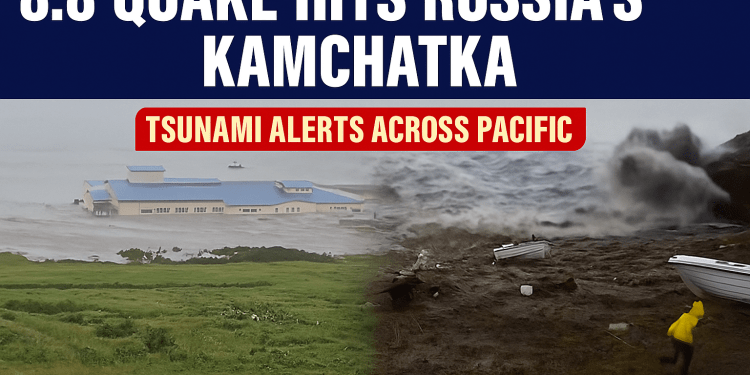The Kamchatka Earthquake and Pacific Tsunami: July 29–30, 2025
The July 29–30, 2025 Kamchatka earthquake generated a Pacific-wide tsunami warning that resulted in waves across the Kamchatka Peninsula, Japan, Hawaii, Alaska, New Zealand, and Mexico.
Seismology and Epicenter
8.8 Magnitude Earthquake in Kamchatka Triggers Pacific-Wide Tsunami Alerts
8.8 Magnitude Earthquake in Kamchatka Triggers Pacific-Wide Tsunami Alerts
The extensive 8.8 magnitude earthquake, ranked among the strongest seismic events in recent decades, occurred about 119 km east-southeast of Petropavlovsk-Kamchatsky at a 19–20 km depth.
It originated from reverse fault movements along the subduction zone at the Kuril–Kamchatka Trench, where the Pacific Plate sinks beneath the North America/Okhotsk plate—a region historically active with megathrust quakes (1952, 1841, 1923).
Prior to the mainshock, a series of four major foreshocks (M6.7–6.9) and over 130 aftershocks (M4.0+) occurred over the next few days, including multiple M6+ events. (The Watchers)
Tsunami Development and Regional Impact
The Pacific Tsunami Warning Center (PTWC) validated tsunami waves reaching 3–4 meters in Severo-Kurilsk, causing port damage but minimal injuries and infrastructure damage.
In Japan, 60 cm waves reached Hokkaido, prompting evacuations and restricted travel, with no casualties reported. ()
Hawaii issued a tsunami warning, later downgraded to an advisory. Although hazardous ocean currents and minor wave surges were recorded, no significant damage occurred. ()
The U.S. West Coast (California, Oregon, Washington) and British Columbia, Canada received advisories, predicting 30–60 cm waves, strong currents, and potential beach flooding.
The tsunami reached across four continents, impacting Mexico, New Zealand, Fiji, Samoa, and other Pacific island nations.
Emergency Response and Evacuations
In Kamchatka, emergency services moved coastal residents to elevations of 30–40 meters and 2–3 km inland. (euronews)
PTWC’s threat alert expired after confirming no significant sea level rise in Hawaii and other regions.
Japan’s meteorological agency reduced its warning based on wave activity remaining near coastal current levels.
The Mexican Navy advised residents to avoid beaches along Ensenada and Chiapas.
New Zealand and Pacific nations warned of strong, irregular ocean currents, urging people to avoid harbors and beaches.
Authorities emphasized tsunamis may produce multiple waves hours apart—later waves can be stronger than the first. ()
Historical Context and Seismic Legacy
Kamchatka’s seismic history includes the devastating 1952 Mw 9.0 Severo-Kurilsk earthquake that generated 18-meter waves and killed over 2,300 people across the Pacific, including in Hawaii, Japan, Alaska, Chile, and New Zealand.
Earlier quakes in 1841 and 1923 also caused 8-meter wave run-ups and deaths in Hawaii.
The July 2025 quake (Mw 8.7–8.8) ranks among the region’s strongest in modern history. Its epicentral location and fault-slip characteristics led to relatively lower shaking intensity.
The event tested and validated Pacific emergency response systems and highlighted the effectiveness of early-warning mechanisms.
Lessons Learned and Safety Measures
Preparedness emerged as the critical takeaway.
Tsunami warning systems like NOAA’s DART buoys and seismic alert networks enabled proactive evacuations across multiple nations.
Public education about natural warning signs and evacuation compliance played a key role in minimizing risk.
Russia, Japan, the U.S., Mexico, Canada, and Pacific Island states collaborated efficiently, reinforcing the value of international coordination and unified alert standards.
Ocean depth and underwater topography greatly influenced wave intensity—continental shelves amplified waves, while deeper zones reduced threat further offshore.
Final Thoughts
The Kamchatka earthquake-tsunami event of 2025 allowed scientists to observe real-time seismic propagation across the Pacific.
Advancements in seismic monitoring and preparedness meant that despite the quake’s magnitude, infrastructure damage and casualties were minimal.
Authorities canceled warnings promptly after threats passed, preventing panic. Minor flooding and traffic disruption were reported in select areas.
This event underscores how earthquake-induced tsunamis are increasing in threat—especially due to climate change and rising sea levels—and why ongoing investment in warning systems, drills, and public awareness is essential.
Countries Affected or Warned
| Region / Country | Tsunami Alerts / Measures Taken | Impact Summary |
|---|---|---|
| Kamchatka (Russia) | Evacuations; local flooding up to 3–4 m | Coastal infrastructure flooding; minor injuries |
| Japan | Prefectural evacuations; coastal travel suspension | Waves ~60 cm; no casualties |
| Hawaii (USA) | Initial warning → downgraded to advisory | Strong currents; advisory only |
| Alaska / U.S. West Coast | Advisories; coastal restrictions | Small waves; no structural damage |
| Canada (British Columbia) | Coastal advisory | Waves under 1 m; currents reported |
| Mexico (Pacific coast) | Alerts for early morning wave arrival | No damage yet reported |
| New Zealand & Pacific Islands | Strong current warnings; beach closures | No widespread damage yet noted |
Conclusion
An 8.7–8.8 magnitude earthquake struck Kamchatka in July 2025, triggering widespread tsunami waves throughout the Pacific Ocean. Thanks to early-warning systems and international coordination, loss of life and structural damage were minimized.
As climate risks grow, the Kamchatka tsunami reminds the world of nature’s power and the importance of continual investment in coastal preparedness, public awareness, and global seismic response.

